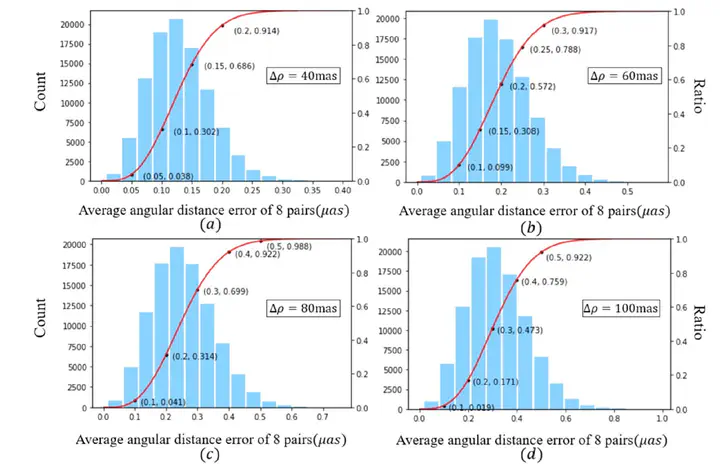 Effect of optical-axis deviation on angular-distance precision (Tan et al. 2022, RAA 22:025008)
Effect of optical-axis deviation on angular-distance precision (Tan et al. 2022, RAA 22:025008)Abstract
For detecting exoplanets with high precision, the angular distance between two stars can be used to detect the periodic motion of a star, which avoids introducing catalog position errors from traditional photographic astrometry. At the microarcsecond precision level, the effect of optical axis deviation becomes non-negligible. This study evaluates the impact of optical axis stability on relative angular-distance measurements through theoretical analysis and numerical simulations. When the angular-distance error is limited to 1 μas, the upper limit of optical-axis deviation is found to be 68 milliarcseconds. The corresponding error allowance is given, and the impacts of CCD distortion and focal-length variation are discussed. The results provide design guidance for high-precision astrometric telescopes such as CHES.
High-precision astrometric detection of exoplanets requires extreme control of instrumental systematics.
Tan et al. (2022) analyzed the impact of optical-axis deviation on relative angular-distance measurements
between star pairs, combining theoretical derivations with numerical simulations.
They found that to maintain a precision of 1 μas in relative astrometry, the telescope’s optical-axis stability must be
better than 68 mas.
They further provided corresponding error budgets and mitigation strategies,
including field-of-view rotation to reduce distortion variations and laser-collimation systems to monitor focal-length changes.
These results offer quantitative constraints for the optical design of space astrometric missions such as CHES.
Citation:
Tan, D.-J., Liu, J.-C., Zhu, Z., & Liu, N. (2022). Evaluating the Impact of Optical Axis Stability on Exoplanet Detection.
Research in Astronomy and Astrophysics, 22:025008. https://doi.org/10.1088/1674-4527/ac3df1